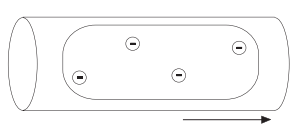Conductors, Insulators and Semiconductors
Conductors
An electric current is produced when free electrons move from one atom to the next. Materials that permit electrons to move freely are called conductors. Copper, silver, aluminum, zinc, brass, and iron are considered good conductors. Copper is the most common material used for conductors and is relatively inexpensive.

Insulators
Materials that allow few free electrons are called insulators. Although these cannot totally restrict the free flow of electrons, they can be used for two purposes: To prevent injury and damage to life and property, and to prevent electrons from moving to other conductors especially those that flow in the opposite direction.
Materials such as plastic, rubber, glass, mica, and ceramic are good insulators.

Cables
An electric cable is one example of how conductors and insulators are used. Electrons flow along a copper conductor to provide energy to an electric device such as a radio, lamp, or a motor. An insulator around the outside of the copper conductor is provided to keep electrons in the conductor.

Semiconductors
Semiconductor materials, such as silicon, can be used to manufacture devices that have characteristics of both conductors and insulators. Many semiconductor devices will act like a conductor when an external force is applied in one direction. When the external force is applied in the opposite direction, the semiconductor device will act like an insulator.
This principle is the basis for transistors, diodes, and other solid state electronic devices.
![]()
